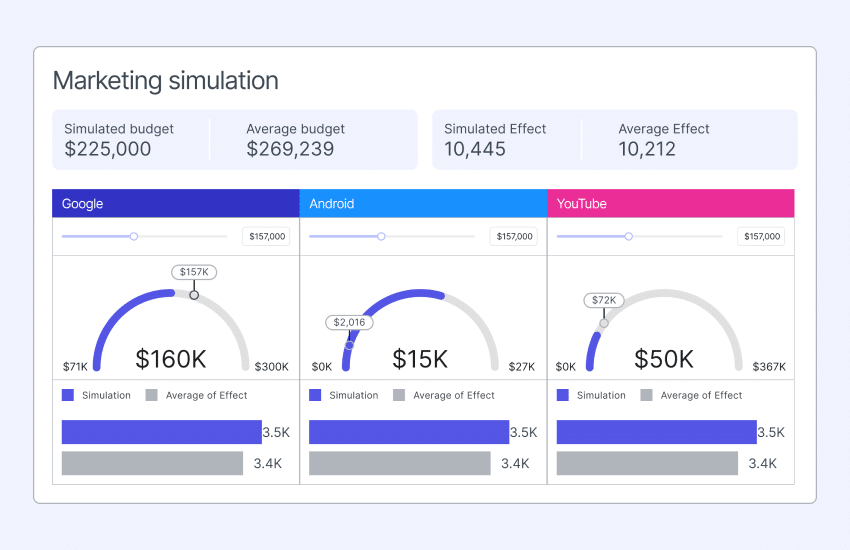It’s hard to say whether peanut butter or chocolate is more delicious. But many people agree that peanut butter with chocolate is one of the best food combinations of all time. (We promise this will connect to marketing analytics.)
Today’s marketers know that data drives performance. That’s why understanding and optimizing marketing performance using data-driven insights has never been more important. As marketing teams strive to understand (and maximize) their impact, two powerful analytic methods stand out: attribution and marketing mix modeling (MMM).
But which one should you use to track performance and optimize your campaigns? Just like the irresistible fusion of peanut butter and chocolate, these two methodologies, when combined, create a true recipe for success. (See, we told you the analogy was relevant!)
First, we’ll dig into the strengths and limitations of attribution and MMM. Then, we’ll explore how AI-driven MMM can complement attribution to bring your marketing campaigns to a whole new level (think three-tiered peanut butter chocolate cake).
Use attribution modeling to analyze historical events
Attribution modeling is like a microscope for marketing. It zooms in on individual marketing channels, helping you understand which assets or tactics contribute most to conversions. Specifically, it provides insights into channel effectiveness, customer journey dynamics, and conversion credit allocation. It’s a great addition to any marketing analytics tech stack.
Common types of attribution include:
- First-Touch Attribution: This method gives credit to the customer’s first interaction with the brand, for example, an asset or a web page.
- Last-Touch Attribution: This method attributes all the credit to the last interaction before a prospect converts — think demo video or bottom-of-funnel white paper or datasheet.
- Linear Attribution: In this method, the attribution is distributed equally among all touchpoints in the customer journey.
- W-Shaped Attribution: This technique gives credit to the assets interacted with at three specific parts of the customer journey: the first, middle, and last interactions.
- Time Decay Attribution: This method attributes more credit to touchpoints that are closer to conversion. This can be helpful if some customers have an especially long sales cycle.
- Algorithmic Attribution: In this technique, data-driven algorithms assign credit based on the observed impact of different touchpoints.
As you can see, there are many different types of attribution, and finding the perfect technique can involve trial and error. And while attribution can be helpful in many instances, it has its limitations.
Think about the journey of a chocolate bar: Before you can even get close to taking a bite, a cacao tree must mature for over five years, with its cacao pods taking another six months to ripen. And along the way, you could use many different types of fertilizers and formulas, but you’re never sure if you’re using the right one.
Similarly, attribution systems involve meticulous groundwork to ensure accurate data tracking. It requires everything from cross-functional collaboration and data integration to quality assurance. Put simply, it takes a lot of time and resources to manage and implement.
Moreover, interpreting intricate data requires skilled analysts, which are scarce and expensive. Attribution systems also only offer retrospective insights, and past performance isn’t always indicative of future performance. Plus, customer journeys today rarely follow a linear path. It’s much harder to attribute credit when an individual’s buying journey involves interacting with an online campaign, an offline campaign, and visiting a store before making a purchase.
In light of the evolving landscape with the decline of third-party cookies and changes in iOS and the SKAdNetwork, attribution now faces even more setbacks in accurately tracking customer interactions. These difficulties call for marketers to start testing and implementing alternative marketing measurement methods.
Attribution modeling excels at understanding channel impact on conversion rates, but these models often lack the forward-looking perspective needed to optimize future marketing strategy.
How marketing mix modeling (MMM) identifies omnichannel performance
That’s where marketing mix modeling comes in. MMM is more like a data-driven compass, measuring the incremental impact of campaigns across channels to inform marketing strategy.
While MMM is a statistical model that businesses have used for decades, automated machine learning (AI) has amped up what MMM can do to provide much faster, more accurate, and actionable insights. With its top-down approach, MMM dissects all marketing efforts. Seriously, all of them.
By offering a comprehensive view of omnichannel performance (online and offline), MMM can guide budget allocation decisions. MMM can also examine cross-channel influences, helping marketers better understand the modern customer journey, like recognizing an online campaign’s impact on a surge in in-store visits.
And unlike attribution’s gradual growth, MMM built with machine learning has a very short implementation timeline. (It’s like buying mature cacao trees ready for harvesting rather than planting them from seed and waiting for them to mature.) As a remarkably user-friendly option, MMM delivers actionable outputs quickly.
Here’s an everyday example. MMM conducts scenario testing, allowing you to simulate the impact of adjusting marketing spending across YouTube and LinkedIn. This gives you a highly-informed preview of the outcomes of a new strategy prior to implementation.
MMM also delivers detailed insights into the influence of external variables on revenue (it’s summer and purchases for your product are sky-high this time of year). This helps your business understand the external forces at play. With unprecedented agility, MMM is a window into all channels’ performance and predictive guidance for future decisions.
But while MMM offers a bird’s eye view of channel performance, MMM lacks the granularity to inform very specific campaign decisions. These models, however, thrive on data related to channel spend and outcomes, making it a practical choice for many businesses.
Moreover, for brands characterized by longer customer decision cycles, MMM captures the long-term effects of marketing efforts that short-term attribution models can’t provide.
Best-in-class Marketing Mix Modeling — driven by advanced machine learning — utilizes fast-moving and granular optimizations to improve marketing ROI by 14-38%.
— “Growth through Privacy-First Measurement,” Accenture
Why you don’t need to choose between attribution and marketing mix modeling
Put simply, attribution provides granularity for specific campaign decisions. What marketing mix modeling lacks in granularity, it makes up for in its ability to rapidly produce predictive information and simulate different budget scenarios across online and offline channels.
In many cases, marketing performance will benefit from both. But it’s not one-size-fits-all. It comes down to business preferences. The choice between attribution and MMM hinges on available resources and data infrastructure. Each approach caters to distinct needs, warranting a customized decision-making process. In fact, we recommend seeking expert guidance to understand how your team can put your marketing budget to good use.
For a retail marketing team focused on boosting sales revenue and optimizing budget, it makes sense to employ both attribution and MMM. They might use attribution to fine-tune ongoing digital campaigns based on real-time performance data. At the same time, they would use MMM to identify the most effective channels and tactics for their long-term marketing mix. Gaining insights at both macro and micro levels positions this retailer far ahead of its competitors.
Embrace the fusion for maximum performance
Rather than opponents in a competition, attribution and MMM are complementary forces. Imagine them as that irresistible peanut butter and chocolate combo. While MMM offers strategic direction, attribution unveils the details of channel interactions. The fusion of attribution and MMM empowers marketing teams to craft campaigns precisely and purposefully — and plan for the future.
Remember that your tools should align with your goals, available resources, and desired level of detail. Regardless of your approach to marketing analytics, embracing data-driven decision-making is the ticket to success in modern marketing.
Want to take a closer look? Get in touch with us to chat about how MMM can fit into your marketing measurement strategy.







